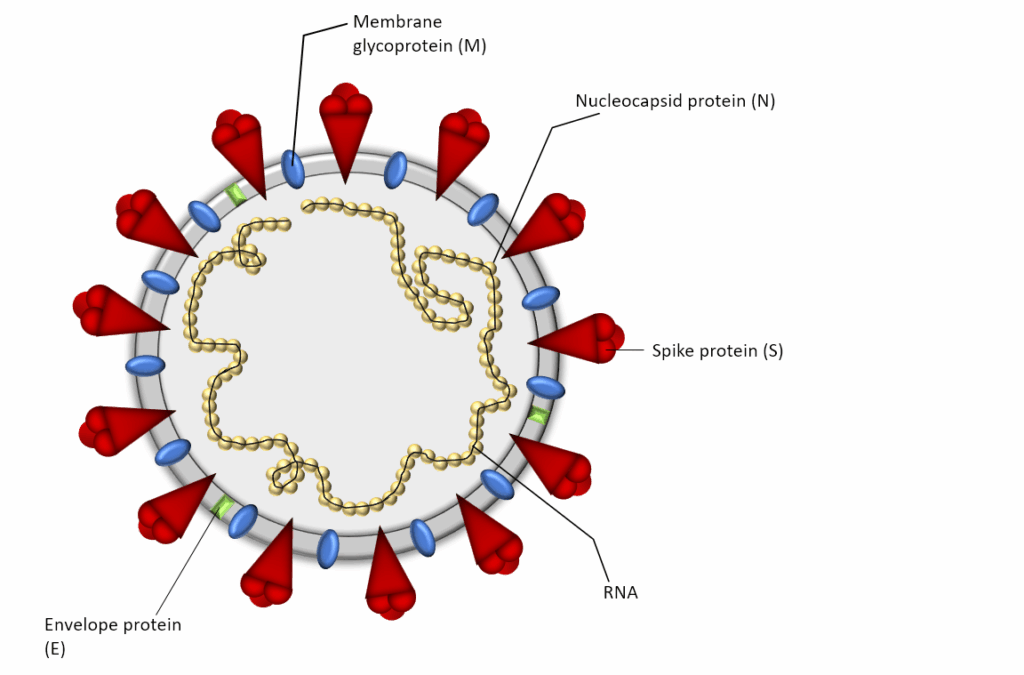The Science of Covid-19 Copy
Covid-19 Explained
- SARS-CoV-2 is the name of the virus.
- It was first identified in Wuhan in China in December 2019.
- The name of the disease that is associated with SARS-CoV-2 is Covid-19.
- SARS-CoV-2 stands for Severe Acute Respiratory Syndrome Corona Virus 2.
- The disease spread across the world and is now a Global Pandemic.
- We now need to learn to live with and control this virus as it is now a part of our everyday lives.
Characteristics of SARS-CoV-2 Virus
- It is a ball of genetic material with spike proteins.
- It is the spike proteins which attach to the human cell, infecting a person with the virus.
- These proteins attach onto the lung and cause the disease.

How is the Virus Spread
There is two ways the virus is spread:
- Direct Contact
- Indirect Contact
Direct Contact
- A person infected with Covid-19 coughs or sneezes in your presence.
- If you are not practicing safe social distancing i.e. within 2m, you can pick up the virus from them directly.
- It is very important the 2m rule is maintained to keep yourself and others safe.
- Face coverings and masks will also help reduce the spread of the virus physically.
Indirect Contact
- A person who is infected with the virus coughs and sneezes into their hand and then touches an object such as door handle etc.
- The virus is then transferred onto the surface.
- If a non-infected person then touches the infected surface and in turn touches the nose, mouth or eyes.
- The virus can then get into their system, attach onto the lungs and infect the person with the disease.

Signs & Symptoms of Covid-19
- Fever
- Cough
- Breathlessness
- Loss of taste and smell
- Fatigue (in some cases extreme fatigue)
If you are suffering from any of these signs or symptoms, you should self-isolate and contact your GP and request a test immediately.

Contact Tracing
- If you feel you have experienced any of the above symptoms you must ensure you contact trace.
- Contact tracing log. The HSE will request your close contacts. They will notify them and request that they self-isolate or restrict their movements and get tested themselves.
Vulnerable Groups
There are a number of vulnerable groups in society that need to be protected. These include:
- People over the age of 70.
- People with underlying health conditions.
Control Methods to Prevent the Spread of Covid-19
- Virus is transmitted via physical contact – ensure physical and social distancing (2m) is being maintained and correct use of facial coverings.
- The virus can survive on hard surfaces. Cleaning and sanitising of frequently touched objects is vital.
- Correct hand washing and hand sanitisation is also very important. Wash for at least 20 seconds and dry them properly.
- Work from home where possible.
- If you do have to go into work ensure correct policies and procedures are put in place and hazard and risk assessments completed.
- Ensure there is not too many people within the workplace at the one time.
- Rotate the workforce.
- Stagger start times, break times and finish times.
- Minimise the number of people allowed in canteen at one time.
- Ensure there is always good ventilation.
- Avoid dark, poorly ventilated areas like elevators and lifts.
- Avoid sharing of items e.g. pens, cups, cutlery etc.
- If you have to share work equipment, ensure they are cleaned and sanitised after each use e.g. photocopiers and scanners.
- Ensure all staff are trained on best practice procedures.